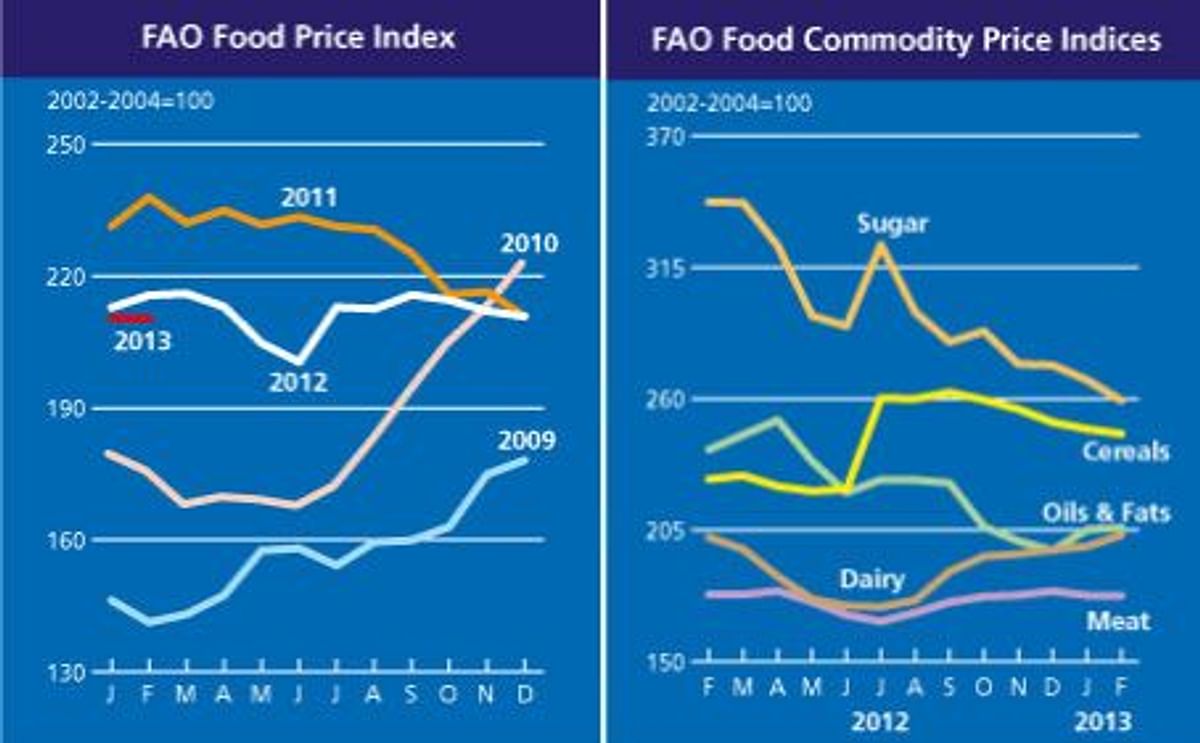The FAO Food Price Index averaged 210 points in February 2013, unchanged from January but five points (2.5 percent) below the corresponding month last year. Since November the Index has moved within a narrow 210 - 212 point range, as increases in the prices of dairy products and oils/fats were largely balanced out by declines in the prices of cereals and sugar. Meat prices were generally stable over the period. In February dairy prices increased most, followed by oils/fats whereas cereals and, especially, sugar prices fell.
The FAO Cereal Price Index averaged 245 points in February, down just under 1 percent from January but still 8 percent higher than in February 2012. Last month’s decline mainly reflects the drop in wheat prices and to a lesser extent maize, while rice values strengthened slightly. Wheat prices eased in recent weeks, reflecting improved crop prospects in the US, while maize prices remained firm, on tight old crop availabilities. The increase in rice prices was mostly a reflection of policy support in Thailand and India and a tightening of supplies in the US.
The FAO Oils/Fats Price Index averaged 206 points in February, up marginally (0.4 percent) from January. The rise was driven by palm oil, mainly reflecting the expected seasonal production slowdown and reduction in inventories from their current high levels. Lower soyoil values and weaker demand from the biodiesel sector prevented the index from rising further.
The FAO Dairy Price Index averaged 203 points in February, 5 points (2.4 percent) higher than in January and representing the most substantial increase since September 2012. The rise was principally a reflection of recent hot and dry weather in Oceania, leading to milk production falling off steeply and a concomitant reduction in the processing of dairy products. Supply limitations combined with firm international demand have caused the prices of all milk products, in particular butter and milk powder, to move upwards.
The FAO Meat Price Index averaged 178 points in February, the same level as January. Quotations for the different types of meat showed some variation with poultry slightly lower and pork marginally higher, while other types of meat remained largely unchanged. High feed prices continue to be of prevailing concern to the industry, while at the same time consumption growth is limited. As a reflection of these factors, the meat index has remained largely unchanged since October 2012.
The FAO Sugar Price Index averaged 259 points in February, down 8.6 points (3 percent) from January. Prices have declined for the fourth consecutive month, on expectation of a relatively large world production surplus and improved export availabilities in the 2012/13 marketing season, most notably in Brazil and Thailand. Sugar production is also foreseen to be large in the traditional importing countries, a factor which also weighs on prices.
World Food prices steady in February

Like to receive news like this by email? Join and Subscribe!
Get the latest potato industry news straight to your WhatsApp. Join the PotatoPro WhatsApp Community!
Sponsored Content
Sponsored Content
Sponsored Content
Sponsored Content









